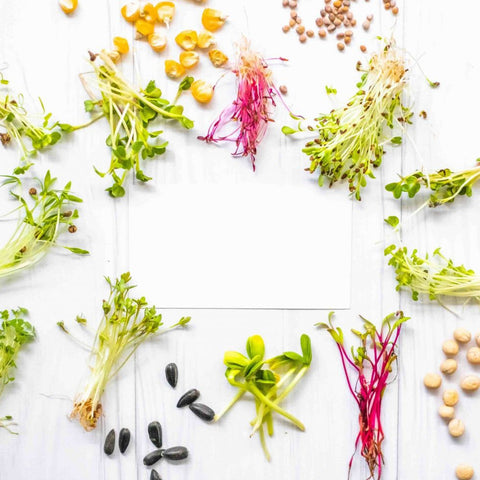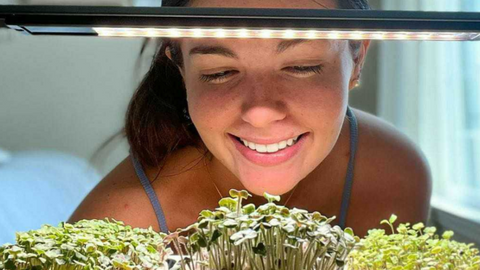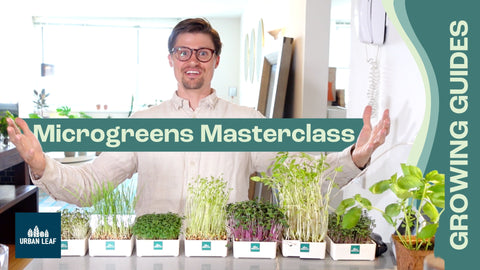Perhaps you’ve heard about microgreens recently, and now you’re curious why people are getting so excited about these tiny edible plants. Or maybe you’re already aware that microgreens are a great way to add more plant-based nutrients to your diet, but you’re unsure where or how to start with them.
Microgreens can be either purchased or grown at home. Purchasing them at a store will almost certainly mean you end up paying more for them, plus they will not be as fresh or nutritious as ones you grow yourself.
By the end of this blog, we hope to have not only explained what microgreens are all about but also provided a few tips and pointers so that you can start enjoying all the freshness and nutritional value that these baby greens have to offer right from the convenience of your own home.
What Are Microgreens?

Depending on the stage of development of an edible plant, we give it a different name. Sometimes we eat them as seeds (grains), some right after they germinate and before they have leaves (these are called sprouts), and if we let them grow a little longer (typically 1-2 weeks) then these baby plants become what is commonly referred to as ‘microgreens’.
Microgreens are typically harvested after they have formed a pair of starter leaves, though sometimes they’ve also just started to put out their “adult” leaves.
Another term you may encounter is “shoots” – which basically translates to “large microgreen” and is used for plants where the seedlings are larger, like peas and beans.
What Are The Health Benefits of Microgreens?
The main health benefits of microgreens include:
- Microgreens are incredibly nutrient-dense – meaning they are concentrated sources of vitamins, minerals, and antioxidants. Compared to their adult counterparts, they contain up to 40x the vitamins and a broader spectrum of antioxidants.
- Microgreens are suitable to eat raw which helps them retain their nutrients, as the high heat in cooking can destroy enzymes, vitamins, and phytonutrients.
- When homegrown, they’re fresh! As soon as any plant is harvested, it starts decomposing and losing its nutrients and health benefits. For example, spinach loses 90% of its Vitamin C within 24 hours of harvesting.
To learn more about the health and nutritional benefits of microgreens, we recommend our separate blog titled ‘What Are The Health Benefits Of Microgreens?’
Microgreens Vs Sprouts: Are they the Same? What is the Difference?
On the surface, the difference between sprouts and microgreens seems pretty minor: sprouts are consumed right after the seeds germinate, while microgreens are given a little more time for leaves to develop. In addition, sprouts are consumed whole (root tail and all) while with microgreens, only the above-ground part is eaten.
The way microgreens and sprouts are grown is quite different though – and has some important implications.
Sprouts are most often grown in a jar with just water – and require daily rinsing to combat contamination. There are only a few types of varieties that are well suited to this style, so the options are rather limited in terms of the types of plants you can eat as sprouts.
Microgreens, on the other hand, can be grown in a number of ways, but are grown closer to natural conditions – seeds are planted on a surface with good ventilation. This means that there are tons more options (almost any grain, herb, or vegetable can be eaten as a microgreen) and they require much less attention to grow safely.
We think the extra time required to grow microgreens (compared to sprouts) is worth it because:
- You get access to a wider range of seeds/varieties.
- It’s safer - with less risk of contamination from things like E. Coli.
- They are more versatile - microgreens can be used in salad, pasta, sandwiches, stir-frys, and even smoothies.
- Microgreens generally have more developed and interesting flavors.
Can Microgreens Grow Into Plants?
If you don’t harvest your seedlings at the microgreen stage they can theoretically grow into adult plants, however, it doesn’t make much practical sense to let them do this because:
- Seeding density: When growing microgreens, it is important to take note of the microgreens' seeding density and to pack them in as densely as possible. This means we can get a really nice harvest out of a small space, but it also means that the plants will quickly become overcrowded if allowed to grow larger.
- Increased demands: Young microgreens don’t need much light, water, or nutrients and are perfectly happy with the limited amounts provided by our grow mats. As they grow, they will need more light, and you’ll need to add fertilizer, and water them more frequently.
Neither of these challenges are insurmountable, but if you want to grow full-sized greens, we recommend deciding that from the start, so you can set them up for success.
What Is the Best Way To Grow Microgreens?
There are two ways to grow microgreens at home. The first one is to grow them using soil. Here are its pros and cons:
|
Pros |
Cons |
|
|
Another way to grow microgreens at home involves using grow mats. Here are its pros and cons:
|
Pros |
Cons |
|
|
Jute mats are soaked in water, placed in either a shallow tray or on a screen above a water reservoir, and a lid is typically put on top to help with germination, as the seeds are exposed to air on the top.
Jute mats are again the best material that we found for microgreens use. This is the material we include in the Urban Leaf microgreens kit. To learn more about what is the best way to grow microgreens or how you can grow microgreens at home, click here.
How Do I Eat Microgreens?
There are many ways to eat microgreens. In fact, as they are very versatile, they can be incorporated into almost any dish that you can think of.
Here are some of the most common ways to eat microgreens:
- Mixing into salads.
- Layering in sandwiches.
- Garnishing drinks.
- Seasoning soups.
- Juicing them.
- Adding to stir frys.
Our favorite microgreen forward recipes are:
- Mustard dressed summer salad.
- Ava-kale-do toast.
- Radish and Root Salad.
- Hummus, Tomato, and Lentil Shoot Wrap.
To learn more about how to cook and eat your microgreens, read this article.
If you’re interested in learning more about how to grow microgreens and other edible plants at home, consider grabbing a FREE copy of our eBook below, or joining our email newsletter at the bottom of this page.









Love to learn more.
Living in England UK weather.
Would it be ok to grow them in my greenhouse.
Just newly know about what is Microgreens. Would like to learn more about Microgreens